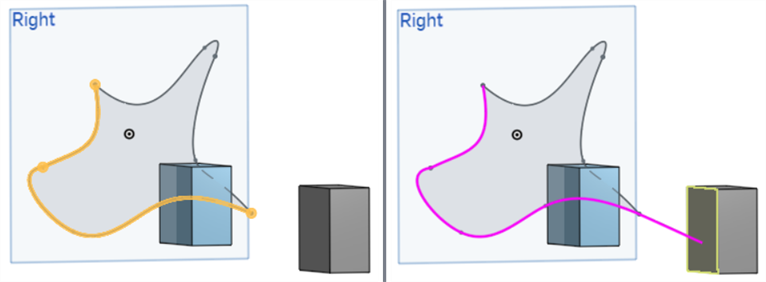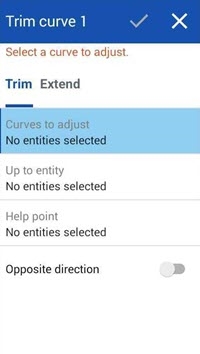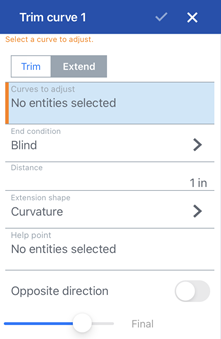 Trim Curve
Trim Curve
![]()
![]()
![]()
Trim or extend a curve by a distance or to a bounding entity.
The Trim curve feature allows you to trim or extend one or more curves by a distance or to a bounding entity.
Click the Trim curve feature tool on the Part Studio toolbar. Select Trim in the dialog if it is not already selected.
Select a curve in the graphics area. Click the Up to entity field in the dialog and select a boundary to trim to in the graphics area (curve, face, edge, or plane). The curve must intersect the entity. Alternatively, trim the curve Up to one or more existing Mate connectors. If one does not exist, click the Mate connector icon to create a new implicit Mate connector. The curve does not need to intersect the Mate connector.
Optionally, select a Help point to guide where the curve is trimmed. The curve is trimmed up to the location closest to the help point.
Optionally, click the Opposite direction icon to select the opposite section of the curve to trim.
Click the checkmark to accept the new trimmed curve.
- Click the Trim curve icon (
 ) on the feature toolbar:
) on the feature toolbar:

- With Trim selected, select one or more curves in the graphics area.
-
Select how to trim the curve, either:
- Up to entity
- Trims the curve to one or more entities (curve, face, edge, or plane). The curve must intersect the entity:

An example of a curve (left) trimmed up to a box face (right).
- Up to one or more existing Mate connectors. If one does not exist, click the Mate connector icon (
 ) to create a new implicit Mate connector. The curve does not need to intersect the Mate connector:
) to create a new implicit Mate connector. The curve does not need to intersect the Mate connector:

An example of a curve (left) trimmed up to a Mate connector (right).
- Up to entity
- Trims the curve to one or more entities (curve, face, edge, or plane). The curve must intersect the entity:
- Optionally, select a Help point to guide where the curve is trimmed. The curve is trimmed up to the location closest to the help point.
- Optionally, click the Opposite direction icon (
 ) to select the opposite section of the curve to trim:
) to select the opposite section of the curve to trim:

A curve is trimmed up to another curve. The trimmed curve and help point are highlighted (left). Using the Opposite direction arrow, the curve is trimmed from the opposite direction (right).
-
Click the checkmark (
 )
)
A combination of entities and Mate connectors can be used.
The Trim curve feature can also extend a curve by a distance or to a bounding entity.
Click the Trim curve feature tool on the Part Studio toolbar. Select Extend in the dialog.
Select a curve in the graphics area. Click the Help point field in the dialog. Then select a point along the curve, for example, a curve end point. The curve extends closest to the selected point. With Blind as the end condition, enter a distance value in the Distance field to determine by how much the curve is extended.
Optionally, click the Opposite direction arrow to extend from the opposite end of the curve.
Select the extension shape. Curvature attempts to match the curvature of the specified curve while extending. Tangent extends the curve while maintaining tangency.
If you prefer, select Up to entity for your end condition, which extends the curve to one or more entities (curve, face, edge, or plane). The curve must intersect the entity. Alternatively, extend the curve Up to one or more existing Mate connectors. If one does not exist, click the Mate connector icon to create a new implicit Mate connector. The curve does not need to intersect the Mate connector.
Click the checkmark to accept the new extended curve.
- Click the Trim curve icon (
 ) on the feature toolbar:
) on the feature toolbar:

- Select Extend.
- Select one or more curves in the graphics area.
-
Select an end condition, either:
- Blind
- Extends the curve a specific length (as entered in the distance field):

An example of a curve (left) extended blindly (right).
- Up to entity - Extends the curve to one or more entities (curve, face, edge, or plane). The curve must intersect the entity:

An example of a curve (left) extended up to a box face (right).
- Blind
- Extends the curve a specific length (as entered in the distance field):
- Select the extension shape, either:
- Curvature - Attempts to match the curvature of the specified curve while extending.
- Tangent - Extends the curve while maintaining tangency.
- Select a Help point to determine which end of the curve is extended. The help point does not have to be on the curve. When a point is selected, the end of the curve closest to the point is extended.
- Optionally, click the Opposite direction icon (
 ) to extend the curve in the opposite direction.
) to extend the curve in the opposite direction.

Two curves are shown in the left image. A curve is extended by distance (curve and help point highlighted in the middle image). Using the Opposite direction arrow, the curve is extended from the opposite end of the curve (right).
-
Click the checkmark (
 )
)
-
To modify sketch entities, first convert them to composite curves.
-
The Opposite direction arrow is independent of the Help point; Select the opposite direction without a help point selected.
In addition to the surfacing tools, curves are used to create the basic building blocks of surfaces.
This lists the collection of curve feature tools. This is not an exhaustive list. Additional Feature tools may be used when manipulating curves.
- Sketch tools - Tools in the Sketch toolbar such as Line, Corner rectangle, Center point rectangle, Center point circle, 3 point circle, Tangent arc, 3 point arc, Spline, Point, and Construction used to create a sketch in a Part Studio.
-
 Helix - Create a helix using a conical or cylindrical face, single axis or z-axis of a mate connector, or circular edge.
Helix - Create a helix using a conical or cylindrical face, single axis or z-axis of a mate connector, or circular edge. -
 3D fit spline - Create a 3D fit spline through a series of vertices. Creates a curve which is listed in the Parts list under Curves.
3D fit spline - Create a 3D fit spline through a series of vertices. Creates a curve which is listed in the Parts list under Curves. -
 Projected curve - Create a curve from the projection of two sketches (Two sketches option) or from the projection of a curve on a face (Curve to face option).
Projected curve - Create a curve from the projection of two sketches (Two sketches option) or from the projection of a curve on a face (Curve to face option). -
 Bridging curve - Create a Curve connecting any two points, vertices, or Mate connectors. The resulting Curve is listed in the Feature list and the Parts list.
Bridging curve - Create a Curve connecting any two points, vertices, or Mate connectors. The resulting Curve is listed in the Feature list and the Parts list. -
 Composite curve - Represent multiple edges as one Curve. Select multiple adjacent edges, sketch entities, and other curves. Selecting non-contiguous edges may result in multiple Curves created. Selections for each Curve must meet at their vertices. (Curves are listed in the Parts > Curves list.)
Composite curve - Represent multiple edges as one Curve. Select multiple adjacent edges, sketch entities, and other curves. Selecting non-contiguous edges may result in multiple Curves created. Selections for each Curve must meet at their vertices. (Curves are listed in the Parts > Curves list.) -
 Intersection curve - Create a curve at the intersection of two or more surfaces or faces. The selections must intersect.
Intersection curve - Create a curve at the intersection of two or more surfaces or faces. The selections must intersect. -
 Trim curve - Trim or extend a curve by a distance or to a bounding entity.
Trim curve - Trim or extend a curve by a distance or to a bounding entity. -
 Isocline - Create an isocline on a sloped face. An isocline runs on a face at positions where the face has a certain slope compared to its reference definition. The resulting isocline is listed in the Feature list and Parts list.
Isocline - Create an isocline on a sloped face. An isocline runs on a face at positions where the face has a certain slope compared to its reference definition. The resulting isocline is listed in the Feature list and Parts list. -
 Offset curve - Create and extend and/or split a new curve by offsetting edges on surrounding faces.
Offset curve - Create and extend and/or split a new curve by offsetting edges on surrounding faces. -
 Isoparametric curve - Create smooth curves that run along a face or surface in the U or V direction.
Isoparametric curve - Create smooth curves that run along a face or surface in the U or V direction. -
 Edit curve - Edit an existing curve by selecting sketch entities or curves to apply a simplified approximation, elevate the degree, reposition control curve vertices and/or planarize into any 2D plane.
Edit curve - Edit an existing curve by selecting sketch entities or curves to apply a simplified approximation, elevate the degree, reposition control curve vertices and/or planarize into any 2D plane. -
 Routing curve - Create a multi-point curve across one or more planes in 3D space (routed path). This is useful for creating pipe routing, wiring, and NURBS curves for advanced surfacing.
Routing curve - Create a multi-point curve across one or more planes in 3D space (routed path). This is useful for creating pipe routing, wiring, and NURBS curves for advanced surfacing.
Trim or extend a curve by a distance or to a bounding entity.
- Tap the Trim curve icon (
 ):
):


iOS (left) and Android (right) Trim curve dialog, with Trim selected.
- With Trim selected, select one or more curves in the graphics area.
-
Select how to trim the curve, either:
- Up to entity - Trims the curve to one or more entities (curve, face, edge, or plane). The curve must intersect the entity.
-
Up to one or more existing Mate connectors. If one does not exist, click the Mate connector icon (
 ) to create a new implicit Mate connector. The curve does not need to intersect the Mate connector.
) to create a new implicit Mate connector. The curve does not need to intersect the Mate connector.
- Optionally, select a Help point to guide where the curve is trimmed. The curve is trimmed up to the location closest to the help point.
- Optionally, toggle Opposite direction to select the opposite section of the curve to trim.
- Tap the checkmark.
A combination of entities and Mate connectors can be used.
- Tap the Trim curve icon (
 ):
):


iOS (left) and Android (right) Trim curve dialog, with Extend selected.
- Select Extend.
- Select one or more curves in the graphics area.
-
Select an end condition, either:
- Blind - Extends the curve a specific length (as entered in the distance field):
- Up to entity - Extends the curve to one or more entities (curve, face, edge, or plane). The curve must intersect the entity:
- Select the extension shape, either:
- Curvature - Attempts to match the curvature of the specified curve while extending.
- Tangent - Extends the curve while maintaining tangency.
- Select a Help point to determine which end of the curve is extended. The help point does not have to be on the curve. When a point is selected, the end of the curve closest to the point is extended.
- Optionally, toggle Opposite direction to extend the curve in the opposite direction.
- Tap the checkmark.